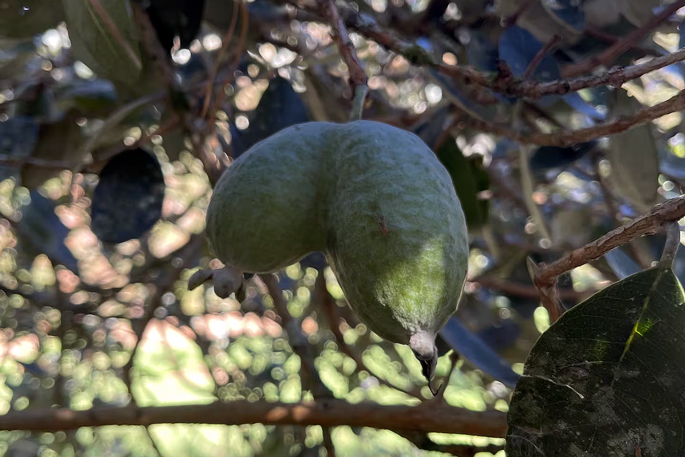An uncommon heart-shaped feijoa found in a couple’s backyard has attracted a $100 offer after a woman listed it for sale.
Anna Wainwright, 25, was collecting feijoas off the ground at her grandparents’ place when she looked up and saw something that made her go: “What the heck.”
In front of her, still hanging on the tree, was a heart-shaped feijoa.
“I’d never seen one like that before,” says Anna.
The self-confessed feijoa fan decided to save the “weird” fruit from scavengers by placing a mesh bag underneath to catch it when it fell. After which, she took it home and thought why not chuck it on Facebook Marketplace for a bit of a laugh.
Up went a photo alongside an $80 price tag and a warning to bargain hunters.
“Price is negotiable but no low ballers I know what I’ve got.”
She told the Advocate she didn’t think she’d get much interest.
 Anna Wainwright's heart-shaped feijoa when it was still in the tree.
Anna Wainwright's heart-shaped feijoa when it was still in the tree.
But Anna was wrong. Messages started pouring in within an hour of the listing being posted.
People said she had made their day, others asked if she was serious.
“There was a lot of interest.”
Buyers put forward offers ranging from $40 to $100. Wainwright replied to the top dollar proposition but was yet to hear back.
She had no plans for any money potentially made but did have a fall back plan if the feijoa didn’t sell.
“Yeah, I’ll definitely eat it. It’s in the fridge but I’m not sure how long it will last.”
Dr Janice Lord, associate professor of Otago University’s botany department, says fused fruit does happen but it's uncommon.
She says a quick Google of “fused fruit” will bring up an array of weird fruits that had to developed into two rather than one.
Such a phenomenon happens at the start of the fruit’s development when a bud starts to become a flower.
“Normally the cells are organised and they’ll start developing into one flower,” says Janice.
“Something like a virus, a bit of damage, or even cold stress - something has happened to the cellular development so two flowers have developed where there should’ve been one.”
Both flowers then produce fruit.
“In the feijoa, that tufty bit at the end is the remnants of where the flower would’ve been. The fruit develops in the ovaries below the flower.”
Janice hasn’t seen a dual feijoa before - mostly because she is Dunedin-based where feijoas don’t thrive as much as in the North.
While a potential sale was pending, Anna is waiting for another interesting feijoa to fall from the same tree.
“This one looks like a butt,” she says.



0 comments
Leave a Comment
You must be logged in to make a comment.